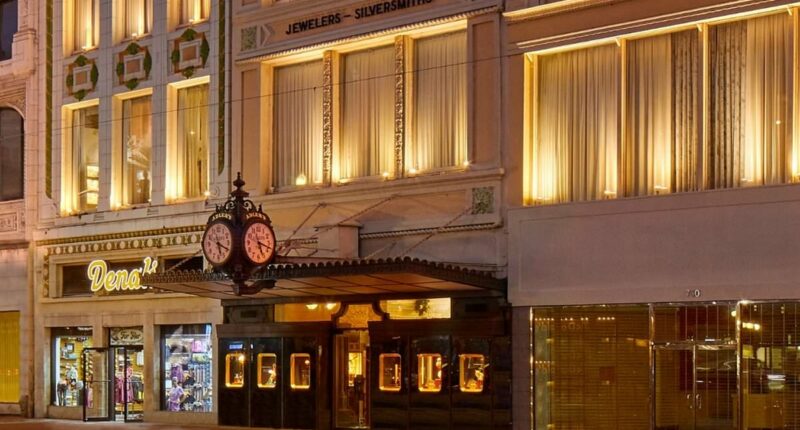Share this @internewscast.com
An emblematic jewelry store with a rich history spanning over a century is closing its doors, with experts pointing to Trump-era tariffs and the escalating costs of precious metals as key factors behind the decision.
Known fondly as the Tiffany’s of the South, Alder’s has graced Canal Street in New Orleans’ famous French Quarter for 127 years. The store has been a cherished destination for those seeking exquisite jewelry, crystal, and housewares, providing timeless gifts for life’s special occasions.
Alder’s earned its distinguished reputation by serving generations of notable Gulf South families, society brides, and affluent tourists. In the regional cultural landscape, it has held a place akin to Tiffany & Co.’s national standing.
However, the cherished Louisiana establishment recently announced that Coleman E. Adler II, the fourth-generation owner and family patriarch, is stepping down. At 82, Adler is retiring after dedicating 62 years to the family business.
“After much thoughtful consideration, I have made the decision to retire. I’m looking forward to enjoying time off,” Adler shared with Biz New Orleans.
Adler has decided to close both the flagship store at 722 Canal Street and a second location in Metairie at 2937 Veterans Boulevard.
‘I will be 83 in January, and I have been doing this a long time. Many of my friends did this a long time ago. It is time,’ he added to Nola.com.
Adler’s is the latest casualty in a wave of 167 jewelry store closures in the America in the first quarter, which is up 20 percent from the same period last year.
Industry experts say part of the pressure stems from aggressive Trump-era tariffs.
‘Tariffs have made it hard,’ Amanda Gizzi, senior vice president of corporate affairs at Jewelers of America, told the outlet.

Alder’s, known as the Tiffany’s of the South, is closing its doors after 127 years

Alder’s joins 167 jewelry stores across the US that closed in the first quarter of this year alone
‘Retailers are eating a lot of the cost to keep from passing it on to their customers’
In April, Trump’s ‘national emergency’ declaration over the nation’s ‘persistent trade deficit’ sparked a global trade war, introducing roughly 10 percent tariffs on nearly every country in the world. Jewelry retailers were particularly affected because many rely heavily on imported gold, silver, diamonds and finished jewelry pieces — much of which comes from India, China and Europe — all now subject to higher tariffs.
The US collected roughly $151 billion in tariff revenue between April and October, according to the Committee for a Responsible Federal Budget.
In turn, the cost of precious metals like gold, which is seen as a safe haven during uncertainty, immediately surged.
Gold prices soared to a record $3,150 per ounce in late March, an 18 percent spike from the start of the year, according to American Gold Standard.
A weakening dollar and slowing economic growth made gold, silver, platinum and palladium more attractive to foreign investors, while central banks bulked up their gold reserves as a hedge.
Trump-era tariffs also fueled inflation by raising the cost of raw materials, including precious metals. For jewelers, soaring gold prices mean higher upfront costs for inventory — often tens of thousands of dollars extra per shipment — squeezing independent retailers whose margins are already thin.

A throwback photo of workers at the New Orlean’s store that offers fine jewelry and timeless gifts

Closing up its two locations – the flagship at 722 Canal Street (pictured) and the Metairie store at 2937 Veterans Boulevard – is part of Alder’s retirement plan

Coleman E Adler II, 82, has announced that he is retiring
Gizzi said shifting consumer tastes are also undermining small local jewelers, as big-name designer brands increasingly dominate the luxury market.
Designer labels now demand premium display space, large minimum orders and costly marketing commitments.
‘A lot of retailers work directly with designer brands, and the designers set terms like any other business that come with strict controls,’ Gizzi told Nola.com.
Meanwhile, owners of legacy jewelry stores — fixtures in older neighborhoods for generations — are aging out, and younger relatives rarely want to take over.
Adler’s four children, who worked with their father for years, declined to assume control of the business.
‘This was the only job I have ever had. I am not going to foist that upon my children,’ he said.
Adler’s roots stretch back to 1898, when founder Coleman E. Adler I immigrated from Slovakia to Alabama before settling in New Orleans, and opening a small gift shop.

Adler’s has been staple of New Orleans, serving customers in its two locations

An expert has pointed to the aggressive tariffs rolled out by President Donald Trump earlier this year as a factor in Alder’s closure

Coleman E Adler I (pictured) opened the store after moving to the US from Slovakia
The store moved to Canal Street in 1902 and, by 1909, settled into its longtime home, becoming one of the region’s premier jewelers.
In 1912, the company created the official Louisiana Centennial coin.
It later crafted the Tulane–Centenary Thanksgiving Day silver football trophy and numerous Mardi Gras pieces.
Adler took over in 1973 at age 29, after his father and uncle – who had joined the business only years earlier – died 30 days apart.
Under his leadership, the store expanded to four locations by the early 2000s, with the Baton Rouge branch operating until 2023.

The store moved to Canal Street (pictured) in 1902 and, by 1909, had settled into its longtime home where it became famed as one of the region’s premier jewelers

Canal Street looks very different today, with hotels and restaurants now surrounding Alder’s
Back then, Adler’s anchored a bustling strip beneath the D.H. Holmes Clock, where women in white gloves shopped and brides registered for china and sterling flatware.
Today, Canal Street has transformed, now dominated by hotels, fast-food chains and tourist T-shirt vendors. The wider area has experienced decades of retail decline, with many legacy businesses shuttering as the French Quarter shifted increasingly toward tourism-driven commerce.

Alder’s stood alongside department stores on the bustling strip beneath the D.H. Holmes Clock

Alder took over the business in 1973 after his father and uncle (both pictured) died within 30 days of each other
‘Our building is iconic on Canal Street,’ Adler said. ‘I don’t intend for that landmark to disappear. I just want to see where else we can go with it.’
The building will remain with his four children, who plan to preserve the family legacy. For now, Adler says there are no plans to lease it to a T-shirt shop.

Alder’s launched a retirement sale on November 10 at both its locations

The building will remain with Coleman E Adler II’s four children
‘What started with one, is now many. Many businesses, many Colemans, many Adler’s, many stories. And many more to come,’ his son, Mickal Adler, told Nola.com.
‘His decision to retire is well-deserved, and I am thrilled that he will finally have time to relax and enjoy life outside of work,’ daughter Millie Adler told Biz New Orleans.
On November 10, Adler’s launched a massive retirement sale at both locations, continuing until all inventory is gone.
In retirement, Adler plans to focus on philanthropy, the arts, historic preservation and preserving his family’s century-long service to New Orleans.
‘It makes me feel excited that I will be able to continue to do something other than this for the good of the community,’ he said.
Both Adler’s and Gizzi did not immediately respond to Daily Mail’s request for comment.





